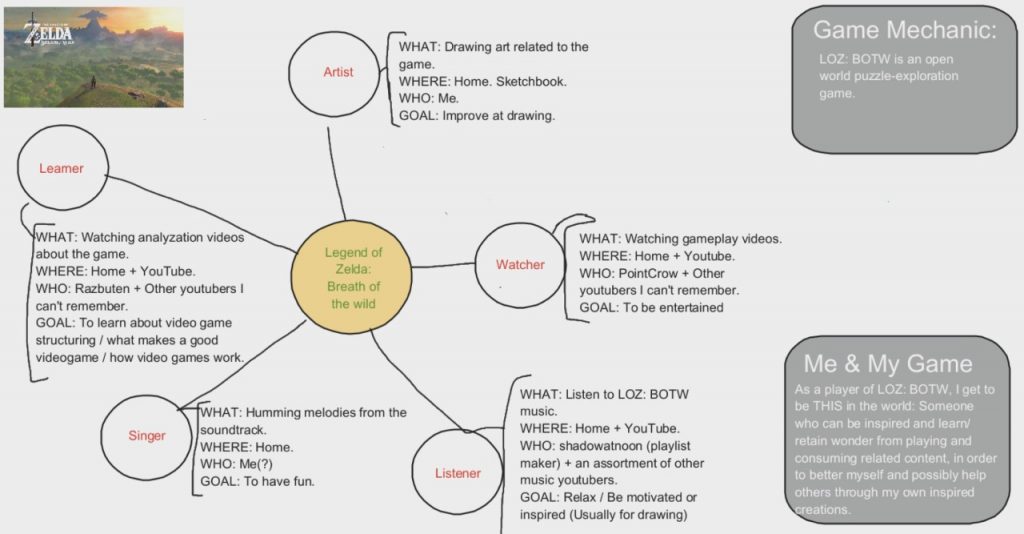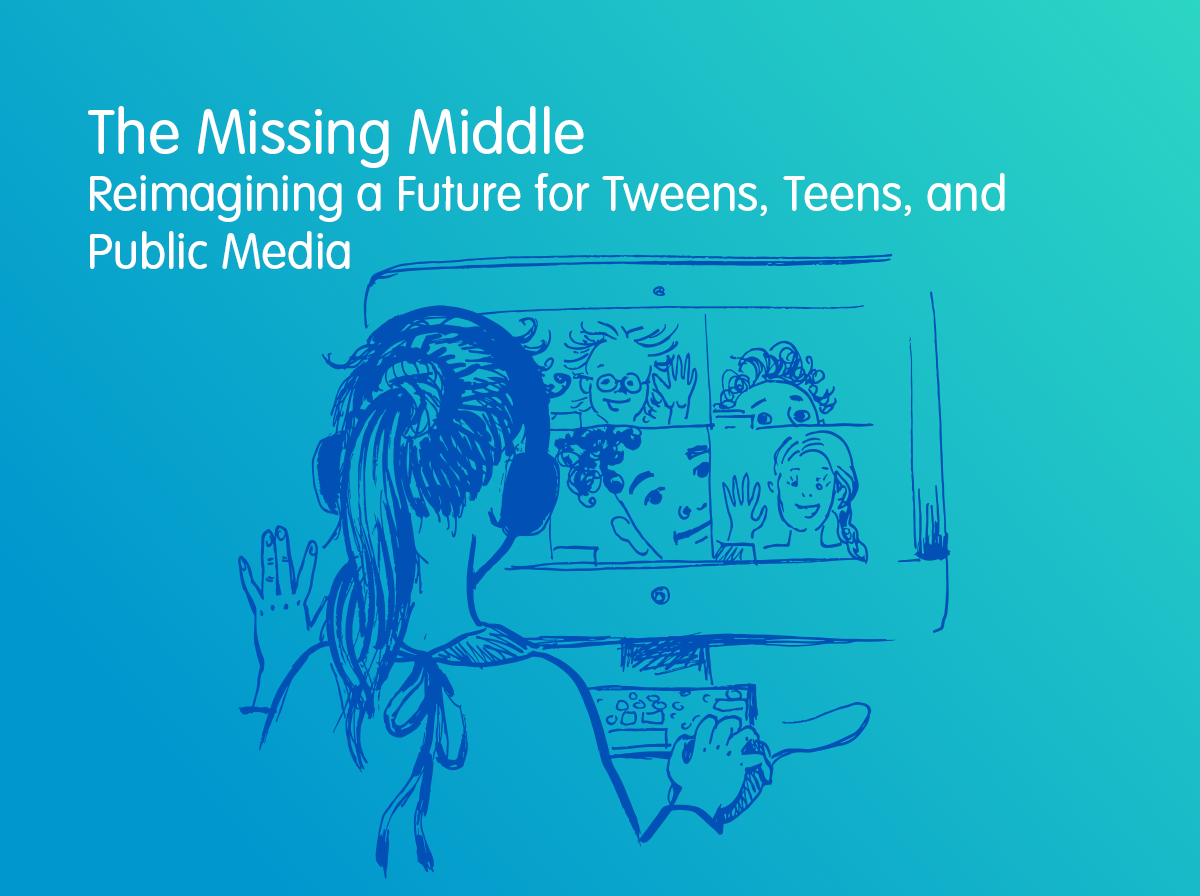“We used to love playing Xbox all day. That used to be great. But now that it’s all we really do or have to do, they’re always like, ‘Oh, I’m so bored of Xbox. I just wanna do something else.’”
(Boy, Age 17 / Pasco County, Florida)
Last year the Joan Ganz Cooney Center launched the By/With/For Youth: Inspiring Next Gen Public Media Audiences initiative. Next Gen Public Media aims to “understand the media habits of tweens and teens and to envision a future of public media that equips young people to participate and thrive in today’s complex world.” While it is explicitly designed to support and instigate the public media sector to develop innovative and unique strategies to better engage young audiences, their research is open to all. It can serve as a source of inspiration for anyone working with youth.
They recently released The Missing Middle: Reimagining a Future for Tweens, Teens, and Public Media. This is an exciting report. Their team spoke with 50 tweens and teens across the U.S. about how they spend their time with media, what issues are important to them, and more. This is the “missing middle” for public television – the viewers aged between those watching Sesame Street and Downton Abbey. They asked these youth for “advice about what media producers should do if they want to engage with people their age” and then spoke with them about how their lives have changed during the pandemic.
I came to this report with a very particular lens. Since December of last year, I have been exploring what role video games play in the lives of today’s youth. That led me to the report with a particular question: How can institutions of higher learning build pathways for high school students based on their deep interest in video games? In fact, during my own research this past winter – focus groups, 1:1 interviews, and surveys with NYC students, college students, and educators – I realized I had been framing it all wrong.
Rather than just ask about the roles played by games in the lives of today’s youth, I began asking them how games help them to be who they want to be in the world. This shifts the focus from games as discrete products to games as portals into rich ecosystems – such as YouTube and Twitch videos, Discord community chats, modding sites, game servers, and more. This shifts the agency from the gaming company (how games impact youth) to the youth (how youth use games). And it frames the question around how youth are making decisions every day – navigating and managing their feelings, pursing their interests, strategizing their lives – and how they are using games as one of many tools to construct their identity and engage the world.
One young man spoke to me about how playing games develops his capacity for learning in school: “Games help us be who we want to be in the world. ‘Cuz when you play your video games, that feeling when you do really good, it’s real motivating. It makes you feel really good about yourself and it makes you want to keep going, like in Apex [Legends], right? Let’s say you’ve been having a bunch of good games lately, you want to keep the streak going, even for days. That can relate to real life. It can be something small, like you’re struggling in math, but you’re starting to get a hang of it, you know, you finally feel like you caught up with everyone, that rewarding feeling – you can kind of trace those two together.”
Another teen, a young woman, spoke about how playing games has prepared her for her planned career in the health professions: “[Games] could have an impact on what you want to do in your future. Because I personally want to work in the emergency room. I want to be a PA [physician’s assistant]. So I feel like when you play games, you need like critical thinking, you need to think fast. And those are some of the things that you need as a PA… to memorize things like when you go to nursing school… They have some factors that have to do with you developing skills for the future.”
Responses like these and others focused on how games themselves helped teens to shape their lives, but usually glossed over or ignored games’ broader ecosystem. To make their journey through the broader world of games and their game communities visible, we came up with a different approach. We started with a sort of mind-map template. In the middle they put in the name of one game. Then, in the surrounding constellations, they described all the different things they did related to that game when they were NOT playing it, who it connected them with (directly or through things they created), and what roles it allowed them to enact.
In the example below, this student chose Legend of Zelda: Breath of the Wild. LoZ helps this student be an artist (drawing LoZ-related art) and a singer (of LoZ melodies), a consumer of LoZ gameplay videos and LoZ-music, and a “learner” of videos that use LoZ to teach game design. The final step in this process is to explore all those roles to look for a unifying narrative, to highlight how the player is using the game’s broader ecosystem to be who them want in the world. In this case: someone who can take inspiration, wonder and learning from one source then apply it somewhere else in order to better themselves and others.

This process allowed me to shift from: How can institutions of higher learning build pathways for high school students based on their deep interest in video games?” to “How can institutions of higher learning build pathways for high school students based on the interests generated through their love of games.” The key shift here is away from fetishizing games themselves, and re-focusing on the broad areas impacted by gaming. So yes, games might inspire youth to go into STEM. But I also heard from youth about how it inspired them or informed their efforts to go into sociology, toy design, event planning and, as noted above, to work in an emergency room.
The new report from the Joan Ganz Cooney Center is not ABOUT games. It is about the broader topic of media. But as they demonstrated, you can’t talk with youth about media without talking about games. In the executive summary, the first of their ten key takeways is:
Video dominates media experiences for youth and is the lifeblood for social media and gaming… We were surprised by the frequency with which tweens and teens rely on how-to videos to support their school work, gaming, creativity, and development of life skills.
The report discusses how games drive video engagement across a wide range of platforms and formats, how the “exceptionally uneven nature of device and console ownership” is having “a profound impact” on their “inclusion or exclusion from social groups,” and the importance of how-to videos.
And when it came to recommendations, there is something here as well for those beyond public media. “When we ask youth for their advice on how public media could create more appealing content for kids their age, the issue of representation is paramount: they want to see kids like them, as well as others who reflect the diversity they see in their generation.” In addition, “Our method of talking to tweens and teens, asking for their opinions, informing what is possible and what might help to fill some of these gaps in commercial media is a model moving forward for public media to consider.” In my design practice, speaking with end users is just good user-based design, which is why both high school and college students are part of my research to inform new pathways to college. But this recommendation can serve as a helpful reminder to us all. Especially when serving youth. As they wrote, “Kids are grateful for a chance to be heard, and they were surprised that we were taking their opinions seriously.”
The report spends a good amount of time addressing youth’s interests in not just consuming something of value but creating something of value, explaining why they spend so much time in social media dialogues (text chats on YouTube, video exchanges on TikTok, photo play on Instagram, etc.). This is framed as speaking to youth interest in representation, in personalization, in peer-produced content. Critics see this “abundance of content and personalization … [as] more noise than promise,” akin to the label applied to television 60 years ago when it was famously called the “vast wasteland”. We all know today how Sesame Street’s founder, Joan Ganz Cooney, responded. The report suggests this is a similar moment, a time that calls for vision to “create a trusted space for learning and growing as youth transition from childhood to adulthood and develop identities deeply intertwined with the media ecosystem.”
I look forward to watching as others respond to that call and participating in projects like this, which are engaging youth in building that bridge to their future.

 Barry Joseph is founder of Barry Joseph Consulting, a driving force at both the strategic and the tactical level in digital engagement, youth development and digital learning. His next book –
Barry Joseph is founder of Barry Joseph Consulting, a driving force at both the strategic and the tactical level in digital engagement, youth development and digital learning. His next book – 
